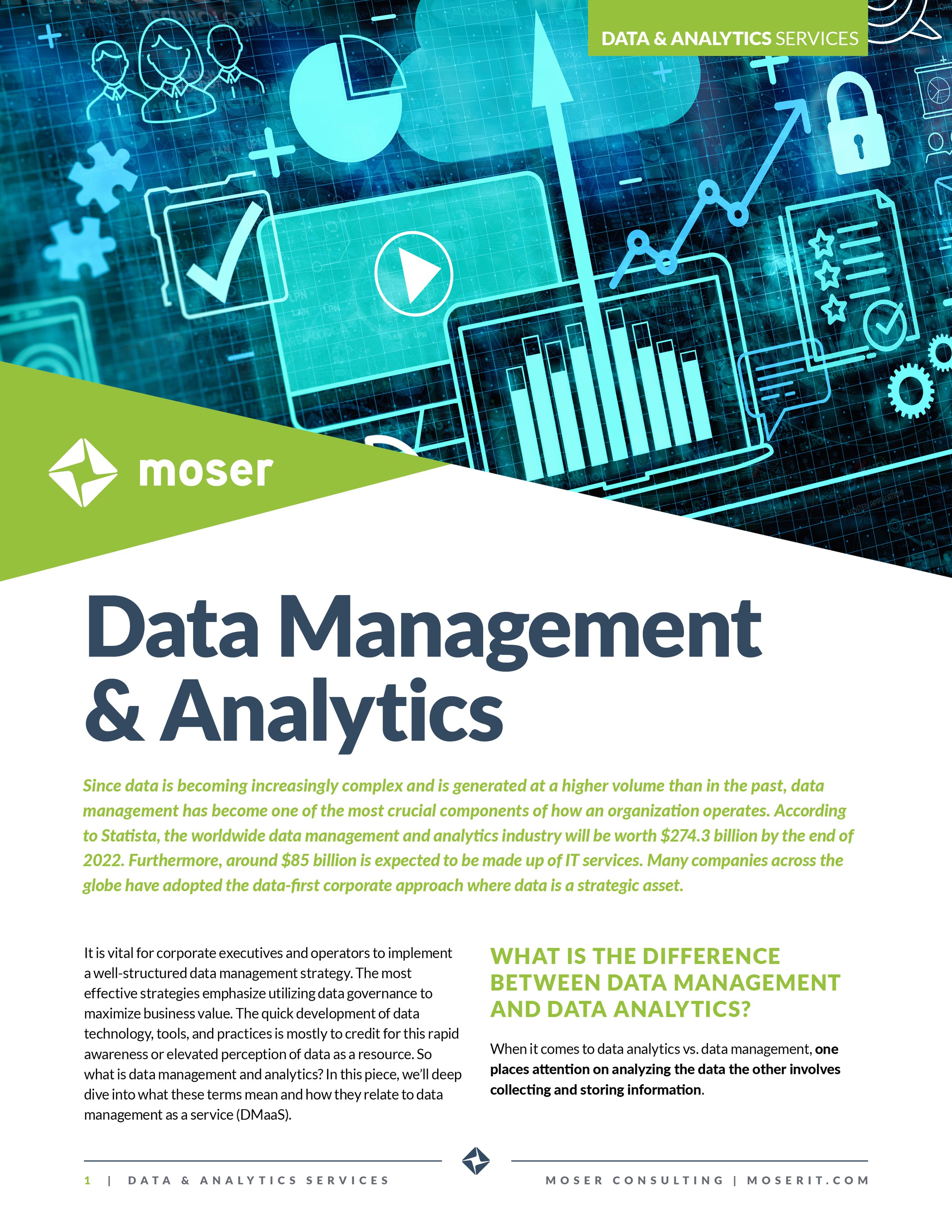
MOSER DEEP DIVE TECH CONTENT:
Data Management Analytics
If you smell smoke when looking at your data, your business will soon be on fire.
Since data is becoming increasingly complex and is generated at a higher volume than in the past, data management has become one of the most crucial components of how an organization operates.
According to Statista, the worldwide data management and analytics industry will be worth $274.3 billion by the end of 2022. Furthermore, around $85 billion is expected to be made up of IT services. Many companies across the globe have adopted the data-first corporate approach where data is a strategic asset. It is vital for corporate executives and operators to implement a well-structured data management strategy. The most effective strategies emphasize utilizing data governance to maximize business value. The quick development of data technology, tools, and practices is mostly to credit for this rapid awareness or elevated perception of data as a resource. So what is data management and analytics? In this piece, we’ll deep dive into what these terms mean and how they relate to Data Management as a Service (DMaaS).
What Is the Difference Between Data Management and Data Analytics?
When it comes to data analytics vs data management, one places attention on analyzing the data the other involves collecting and storing information.
What Exactly Is Data Analytics?
Data analytics examines the value of insights derived from various datasets. Data analytics tools and techniques include producing summary counts of events, generating reports with summarized descriptive statistics, and utilizing visualization tools to create images that represent the information in your data. Analytics also involves using statistical modeling techniques to categorize or otherwise:
Arrange comparable units of analysis into distinct groups
Estimate future occurrences based on historical data
Evaluate the effects of marketing and other initiatives on customer behavior
Applying statistical analysis to data in order to identify trends and resolve issues is the main goal of data analytics.
The duties of data analytics teams include:
Obtaining data from customers or other sources
Ensuring quality data is obtained and used
Interpreting the data and understanding the benefits
Drawing conclusions on how to enhance processes
Using facts, analysis, and judgments to create insightful reports
In short, data analytics is the science of examining unprocessed data to draw conclusions about such information.
Types of Data Analysis
For insights and patterns, data analysts often study raw data. To assist organizations in making decisions and succeeding in finding trends and patterns, analysts employ a variety of strategies. A good data analytics system will provide you a clear picture of where you are, where you have been, and where you should go. There are four basic types of data analytics:
1.
Descriptive analytics describes what has happened over a given period of time by using historical and current data from multiple sources to identify trends and patterns.
2.
Diagnostic analytics leverages descriptive analytics data to determine what is impacting performance and explain why specific events occurred.
3.
Predictive analytics applies methods like statistical modeling, forecasting, and machine learning to create predictions about events happening in the near future.
4.
Prescriptive analytics provides particular solutions to produce desired results and offers a plan of action through testing with advanced analytics.
Data analytics is vital because it contributes to the performance optimization of organizations. Companies may help cut expenses by incorporating analytics into their business strategy to develop fresh, improved products and services.
The data management process involves building databases, uploading data to servers, creating backup and historical copies of files, and assigning permissions to others in the organization to access certain data files. Companies can make a plan to store and share data with data management processes like documentation, security, and backups. In order to make decisions and take actions that will benefit the business as much as possible, data management aims to assist individuals, organizations, and associated stakeholders in optimizing the use of data within the constraints of regulation and policy.
Some examples of data management tasks include:
Creating systems to gather data
Organizing data efficiently and effectively
Providing high availability and disaster recovery
Developing the company's data usage policy
Protecting data security
Monitoring data system performance
Utilizing data within applications, analytics, and algorithms
Data processing, storage, governance, and security are all aspects of a data management system, but the effectiveness of each component depends on the data architecture and technology stack of the organization. By combining these technologies, a company's data infrastructure develops a pipeline for data to be collected, processed, stored, and retrieved.
Data Management and Analytics Regulations
Data management methods that overlap with analytics have to comply with data regulations like the General Data Privacy Regulations (GDPR) in the European Union and the Gramm-Leach-Bliley Act (GLBA) or Electronic Communications Privacy Act (ECPA)—among others—in the United States. Some states have their own privacy laws, like the California Consumer Privacy Act (CCPA). Better governance mechanisms are provided by the new legislation, particularly in the areas of ethics, data security, and privacy.
What Exactly Is Data Management?
Data management is focused on gathering and preparing data to inform various business processes. It also ensures effective and efficient data consumption. Every operation relating to the security, control, distribution, and value enhancement of data is included in data management.
What Are the Four Main Processes of Data Management?
Assessment
The first step in any data management process is to assess the database. In order to establish if particular parts of the data meet established standards, a data quality evaluation is conducted. This will give database administrators (DBAs) the ability to inspect each aspect of your environment. How does it function? Where are the weak points? How much data will be managed and stored? Moser’s assessment will help you create effective data policies and practices that increase IT efficiency. Data management will be especially useful for businesses with a large amount of data at their disposal because assessments of the database will often be more accurate when additional relevant data is provided.
These assessments may employ data management techniques, such as:
Data preparation: Applying corrections and integrating data sets are used to prepare raw data for analysis.
Data warehouses: Locations to combine several data sources, deal with the numerous different types of data that organizations store, and offer a clear path for data analysis.
Data pipelines: Automatic transfer of data across systems.
ETLs (Extract, Transform, Load): Designed to take data from one system, convert it, and put it into the data warehouse of the company.
Data architecture: Creates and manages data flow using a formal approach.
Analysis
The corrective actions that need to be taken are then presented to you after the analysis is complete. This presentation includes recommendations on updated security, where performance might be lacking (and how to solve those problems), and any other database issues that arise.
The presentation helps generate a roadmap, which might include techniques like:
Data Governance: Sets standards, methods, and policies to preserve data security and integrity.
Data Security: Protects data from unauthorized access and corruption.
A formal data management strategy addresses user activities, the capabilities of data management technology, the requirements of regulatory standards, and the organization's goals.
Presentation
Data organization, manipulation, and interpretation are all parts of data analysis. This analysis may be utilized to uncover trends, patterns, and connections in the database. By using analysis software like Structured Query Language (SQL), Snowflake, and Oracle, DBAs can better understand the data you’re storing and determine if it is secure, and discover opportunities for performance optimization. They’ll be asking questions like, “Is the data obtained from a variety of sources or from a single source?” and “Will all data be used in the analysis, or will subsets of the data be analyzed?” Understanding the data and translating it into usable information will help DBAs find any issues and develop a plan for the future.
The analysis may employ data management techniques, such as:
Data catalogs: Assist in the management of metadata in order to generate a full picture of the data, offering a summary of its changes, locations, and quality while also making the data easily accessible.
Data modeling: Documents the flow of data through a system or organization.
Daily Management
Management of data (or maintenance) makes sure everything runs smoothly on a daily basis. Your DBA checks in on the database, consistently runs new analyses, and adjusts the roadmap as necessary. Because of this, DBAs can come up with innovative solutions to fix the problems that might arise. Database administrators secure the database by inspecting the data and searching for data breaches on a daily basis, which means peace of mind with data security.
Database management as a service (DMaaS) teams process these types of data management functions: assessing, analyzing, presenting, and managing your data. These aspects of data management allow administrators to understand your system and offer solutions after evaluating the data. Let’s explore each step further:
What Is the Role of Data Management?
Data management is essential to identifying, alerting, diagnosing, and resolving faults in the database system or underlying infrastructure. Data management makes data more trustworthy so organizations can rely on it when making important choices. Your business will run more efficiently and be more organized with effective data management.
The importance of data management is clear:
Increase in productivity | Better cost-efficiency | Reduced security risks | Decreased data loss | More informed decisions
What Offerings Come with DMaaS?
Offerings with DMaaS from Moser include business continuity, database support and monitoring, performance tuning, and database consulting.
-
With a high availability solution, Moser’s database administrator (DBA) teams can implement infrastructure and other tasks focused on assisting C-Suite executives and management. DBAs concentrate on supporting, troubleshooting, configuring, planning, and looking for vulnerabilities of organizations. This ensures they are prepared to sustain essential services following an emergency or disruption events. These events can include:
• Security breaches
• Natural disasters
• Power outages
• Equipment failures
• Sudden staff departures
Business continuity is a top priority for leading companies because continuing essential operations during an emergency or disruption may be the difference between a company's success and failure. Before a crisis strikes, putting a business continuity plan in place may save a significant amount of time and money.
-
Monitoring database environments on a daily basis is essential to data management and analysis. Moser DBAs set up in-house monitoring solutions to be reactive and proactive. This provides a a supportive environment to address problems before they arise. We also offer an on-call team 24/7— or tailored to an organization's specific needs like business hours or after hours. Moser has its own monitoring piece at the database level for notifications related to:
• Blocking (two people trying to access the same data at the same time)
• Deadlocking (two or more transactions waiting for each other to release locks)
• Long running queries
• Long running jobs
• Event and logins
• Anything else that can affect the performance of the system
The maintenance of the functionality and overall health of your database management system depends on database monitoring. Database monitoring has several processes and offers a broad picture of numerous procedures including resource availability and consumption, tracking throughput, and log tracking.
-
Performance tuning increases a system's optimization by redistributing the available computer, network, or storage resources for easier data retrieval and more timely and comprehensive query responses. If database administrators receive notifications or a client has reached out saying the system is running slow—like getting results or applications not performing—analysis and recommendations are provided along with tuning performance. The goal is to figure out what’s accessing the system and queries. These queries include the structure of the table or index, which allows the query data to be accessed quickly. Anything related to performance issues is addressed by Moser DBAs, especially if things are slower today than they were yesterday.
Here are a few possible reasons in support of performance improvement:
• Accessibility of data within existing networks
• Increased response time for certain apps or users
• Utilization and restructuring of storage space
• Reduced cost of additional services or improved functional capability
-
The database consulting offerings from Moser work with you to assist with any system problems and developing a strategic plan.
Are we upgrading or looking at resources on the system? Our consulting works within your budget and goals. But we also want to answer your questions while assisting with your data management and analytics.
When working on upgrades, what functionality has been depreciated, and what new tech can be used? We also work with vendors that provide a solution to the client with a software package or other offerings. Our consulting service covers anything related to your database while developing a long-term road map.
How do you want to expand and utilize your system as you move forward? Our consulting team will help guide you through all of your needs.
Moser offers all of the database infrastructure and administration tasks for routine maintenance like backups, security, and patching updates.
We ensure daily system health checks, installation of new database services, and network and applications teams to prevent security breaches and hacking into database monitoring.
You will get a dedicated engagement manager assigned to you, as their services are included in the DMaaS package. The engagement manager is the key point of contact. Their goal is to work with you and strategize road maps and make sure the teams and clients are delivering. A custom team of DBAs will be assigned to each client based on the size and scope of the client's IT environment. This will ensure maximum efficiency and reduce the risk of downtime. You’ll get multiple support points for the best data management.
Ready to see the improvements that consistency, quality, and preparation can make?
Contact us for more information and to start working toward a solution today.
WATCH FOR THE NEXT ARTICLE IN THIS SERIES:
Effective data management can save money, increase efficiency, decrease downtime, and strengthen security. The reasons why enterprise data management is important cannot be overstated.
You could also look at the importance of data management through the idea that businesses can’t function without data. Employee data, product specs, customer behavior insights… without this information, your company is stuck playing a guessing game that can have serious consequences for your bottom line and legal standing. However, not all businesses have the resources on-hand to manage their data as effectively as they should. In this guide, we cover the types of data management as a Service so you can see where you excel and where you may need assistance. We also go in-depth to look at how Data Management as a Service and on-demand data management services can fill in the gaps that are holding your business back.
Our experts talk Data Management in our podcast!
S2E12: Data & Analytics Strategy - What To Consider When It Comes To Your Data Engineering
Shaun McAdams and Warren Siffre continue their discussion about the five pillars of Data & Analytics.
This is part 5 of 5 and covers the final pillar: Data Engineering.
Shaun and Warren talk about what companies should be looking for and thinking about when it comes to their data engineering.








